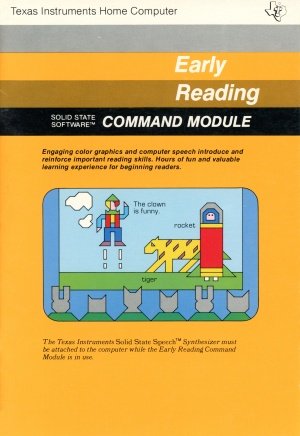Early Reading
Early Reading is an educational software title created by Scott Foresman and Company for the TI-99/4 and TI-99/4A home computer systems. It was released in 1980, soon after the release of the TI-99/4 home computer, being one of the first title for the system. Early Reading was a software title that was able to take advantage of the Speech Synthesizer to enhance the learning capabilities of the software.
| Early Reading | |
|---|---|
 Early Reading (Front Cover) | |
| Publisher(s) | Scott Foresman |
| Programmer(s) | unknown |
| Part# | PHM 3015 |
| Format(s) | Solid State SoftwareTM Command Module |
| Release | 1980 |
| Genre(s) | Educational, Reading |
Advertising Blurb
Front Cover of Manual
Engaging color graphics and computer speech introduce and reinforce important reading skills. Hours of fun and valuable learning experience for beginning readers.
Back Cover of Manual
For a child, learning to read is a magi key that opens doors to adventure and excitement, knowledge and ideas. The Early Readying Command Module combines computer speech, color graphics and enriching activities to give your child a positive and enjoyable experience in learning to read. With this module, Texas Instruments is continuing its tradition of applying innovative Solide State SpeechTM technology to educational activities. The module and the Texas Instruments Solid State SpeechTM Synthesizer provide your computer with a voice that gives directions, introduces new words, reads sentences, and encourages your child to read aloud.
Early Reading module activities include:
- Pick A Picture - Contains nine sections that introduce the module vocabulary to form short stories.
- Pick A Word - Reinforces the vocabulary introduced in Pick A Picture. The game-like format presents sentences, one at a time, that can be completed by selecting the correct word.
- Make A Story - Consists of new stories formed from the module vocabulary. The child makes word choices that determine how the story develops.
By hearing and seeing the words, and by responding to the spoken direction, your child can learn to value and enjoy the reading experience.